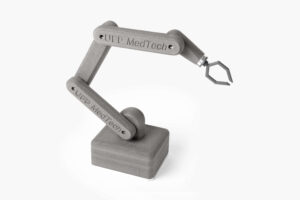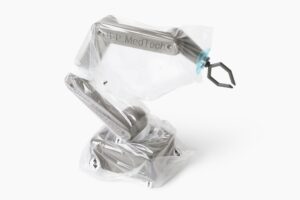Robotic surgery, or Robotic Assisted Surgery (RAS), is one of the fastest growing areas in healthcare due to its continued adoption for a wide range of gastrointestinal, gynecological, cardiac, colorectal, and orthopedic procedures to name just a few.
However, without the proper sterile draping systems in place, these common surgical procedures could be very risky. In order to prevent infection, all exposed areas of the robot equipment are required to be covered with a disposable drape that maintains the full range of mechanical motion, while preserving the sterile barrier. These drapes are highly customized and designed specifically for each robotic surgery system.
Developing these draping systems can be complicated and costly. The following are 5 keys to creating an optimal and highly specialized robotic surgery draping system.
1. Begin With the Basics: Defining Functional Requirements
The goal of a robotic sterile barrier is to cover practically every visible surface of the robotic system and patient surgical zone. In an operating room, where time and infection control are priorities, it’s crucial that disposable robotic sterile barriers are easy to deploy, install, remove, and discard. Considering how the draping system is removed from the sterile packaging and applied to the robot is equally as important as the drape itself to maintain sterility. Typical target draping time is less than one minute.
Further, robotic motions and functional mechanics of the robot must be maintained once the drape is in place. Robot/patient interfaces that include actuation components, robotic end-effectors, surgical ports, sterile adapters, camera mounts, and cannula adapters, for instance, must be considered and accounted for in the development process. Before any other considerations, you must first understand how, where, why, and when each surgical robot and its components will be used, to create the appropriate disposable sterile draping system.
2. Medically Made: Identifying the Right Materials
Typically, there is a combination of various materials used in the production of robotic drapes. The most common are thermoplastic polyurethane (TPU) or Polyethylene (PE) films, adhesives, metal or poly ties, and hook & loop to name a few.
Due to the number of different materials required for each drape, your development partner must have expertise working with a wide range of materials and an understanding of how they work together.
Specifically, TPU has been historically used as a primary sterile barrier in packaging metallic surgical implants & other metal sharps. Being derived from medical grade USP Class VI material, its human safety and infection prevention capabilities are well-established.
TPU is extremely resistant to abrasion, allowing contact with sharp metal end-effectors or friction where repeated robotic motions are expected. This is commonly referred to as arm collision. An engineer can design for predicted high-frequency arm collisions, knowing the TPU resilience is there. If multiple robot arms or arm collisions do not apply, then a more cost effective material such as PE may be adequate.
Additionally, TPU can be thermoformed into complex 3D shapes, providing even greater protection for interfaces between the robot arm and external devices, making it an excellent material choice for most robotic drapes.
3. Bringing It to Market: Manufacturing Processes and Scalability
Many processes are required for bringing a single drape system into large-scale production, such as:
- Film Extrusion
- Thermoplastic Welding & Sealing
- Thermoforming
- Adhesive Lamination & Converting
- Injection Molding
- Cutting & Sewing
- Assembly/Leak Testing
- Packaging & Labeling
- Sterilization
Understanding the requirements of each phase of manufacturing, and how these stages come together will determine your process and scalability. For example, thermoformed parts may need to be functionalized further with more rigid components, such as gaskets or injected molded parts, to enable a robust attachment to the robot. Sometimes an attachment to a drape is also required.
Once the manufacturing process and assembly is determined, putting an infrastructure in place with multiple high-volume, automated drape manufacturing lines in low-cost countries will help scale production.
4. A Full-service Bond: Creating a Strong Partnership
Finding a full-service partner who can design and manufacture turnkey solutions and has strong relationships with material suppliers is highly advantageous. Risk and disruptions can be minimized, or eliminated altogether, when a solid supply chain is already in place.
Besides manufacturing, your partner should provide value-added services to increase your speed to market. These include:
- Design
- Rapid Prototyping
- Full scale robot models for proof of concept, human factors & customer demonstrations
- Packaging
- Sterilization
 |
 |
| A functional foam robot model shown without and with a drape. | |
5. Adding Up the Details: How to Manage Cost
A robotic drape is a single-use, disposable device and therefore cost is an important factor as you scale production. Expenses can ripple through all aspects of manufacturing including materials, flexibility of the design, and labor & shipping, all which ultimately could affect your bottom line.
For instance, using versatile materials like thermoplastic polyurethane (TPU) will provide multiple ways to reduce the overall cost of the sterile barrier. Due to its aforementioned extreme durability, TPU can be thermoformed into 3D shapes with very thin walls (between 2-3 mil in thickness) and still retain exceptional puncture resistance.
Since these walls can be so thin yet durable, parts can be molded with very deep cavities, eliminating the need for more complicated, multi-part assemblies. Thermoforming also allows for designed-in support ribs for areas requiring more rigidity. All of these attributes allow for the use of the thinnest possible starting material, reducing overall cost.
To learn more about developing and manufacturing a surgical robotic drape system with UFP MedTech, contact our team to get started.


